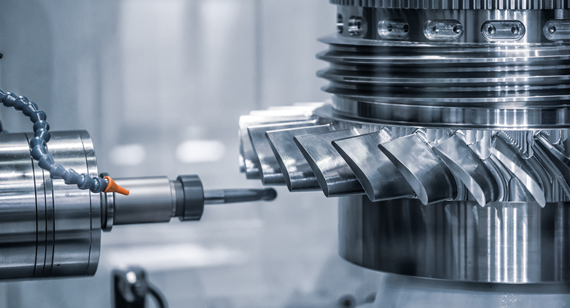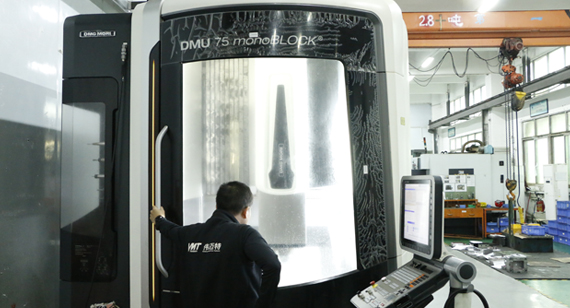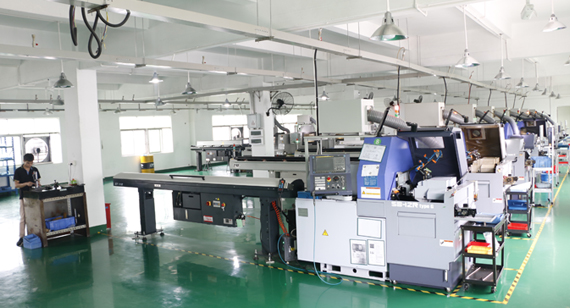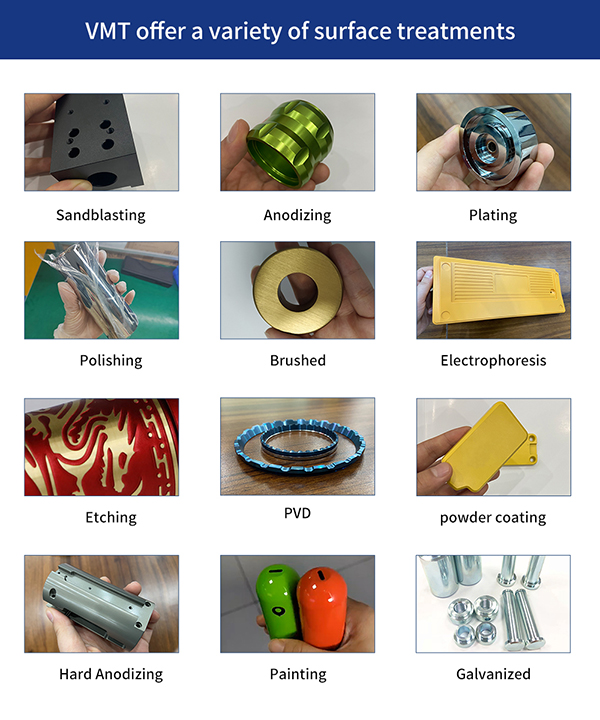15 years one-stop China custom CNC machining parts factory
 158 |
Published by VMT at Aug 22 2024
158 |
Published by VMT at Aug 22 2024
Aerospace CNC machining refers to the high-precision and high-efficiency manufacturing process of complex components in the aerospace sector using Computer Numerical Control (CNC) technology. This process integrates advanced CNC technology, precise mechanical machining, and stringent quality control to meet the aerospace industry's demanding standards for performance, precision, and reliability. This comprehensive guide will cover the basics of aerospace CNC machining, material selection, process advantages, machining techniques, certification standards, surface treatments, machining tips, applications, and the critical importance of precision.
Aerospace CNC machining involves the precise cutting, drilling, milling, turning, and other machining operations on metals, non-metals, and other materials in the aerospace sector using advanced CNC equipment. The process requires not only highly automated and intelligent machinery but also skilled operators with extensive knowledge and experience to ensure stability and consistent quality throughout the machining process.

Precision is critical in the aerospace industry to ensure flight safety and enhance performance. Every part, whether it’s an airframe structure, engine component, or avionics system, must meet strict dimensional, shape, and positional accuracy standards. Even the slightest deviation can lead to system failure or safety incidents. Therefore, aerospace CNC machining must employ advanced techniques and rigorous quality control measures to ensure the stability and reliability of machining precision.
Aerospace machining utilizes a wide range of materials, primarily including lightweight metals, high-temperature alloys, and engineering plastics. Lightweight metals like aluminum, aluminum alloys, titanium, and titanium alloys are widely used for their excellent strength-to-weight ratio and corrosion resistance. High-temperature alloys such as Inconel are used for components that must withstand extreme temperatures. Engineering plastics are chosen for their lightweight, corrosion resistance, and insulating properties and are often used for non-structural components. Material selection depends on factors such as physical and chemical properties, machining difficulty, cost, and environmental considerations.

Creation of Lightweight Components: CNC machining allows for precise control over material removal, enabling the production of compact, lightweight aerospace components.
Minimized Part Errors: Computer-controlled processes reduce human error and deviations.
High Accuracy and Precision: CNC machines offer high-precision positioning and cutting capabilities, ensuring parts meet design specifications.
Consistency: Repeating the same program and parameters in batch production ensures consistency across parts.
Efficiency: CNC machining enables automated and continuous production, significantly boosting efficiency.
Cost Reduction: Although initial investment may be high, CNC machining reduces waste and improves efficiency, lowering manufacturing costs over time.
Complex Geometries: CNC machining can easily handle complex surface requirements, providing greater design freedom.
Speed: CNC machining can quickly adapt to market demands, shortening product launch cycles.
Precision CNC Milling: Utilizes rotating cutters to remove material, suitable for creating complex shapes.

Precision CNC Turning: Uses rotating tools to cut materials in axial and radial directions, ideal for producing shaft-like components.
5-Axis CNC Machining: Adds two rotational axes to the standard X, Y, and Z axes, allowing for complex surface machining.

Swiss Turning CNC Machining: Employs high-precision Swiss machines for producing high-precision, small-batch parts.

Multi-Process Integration: Combines various processes such as extrusion, casting, forging, and CNC machining to optimize results and reduce costs.
Certification is crucial for ensuring product quality and compliance with standards in the aerospace industry. Some key certifications include:
AS9100 Certification: An international aerospace quality management system standard requiring companies to establish and implement comprehensive quality management systems.
ITAR (International Traffic in Arms Regulations): Regulations for controlling the export of military and dual-use technologies, requiring companies to adhere to strict export controls.
AS9102 First Article Inspection Report: Used to record quality checks and conformity assessments of the first production parts.
ISO 9001 Certification: An international quality management system standard applicable to companies across industries.
IATF 16949 Certification: An automotive industry quality management system standard, with some principles and methods also applicable to the aerospace industry.
Aerospace parts often undergo surface treatments to enhance corrosion resistance, wear resistance, and appearance. Common treatments include:
Anodizing: Forms a dense aluminum oxide layer on aluminum surfaces, improving corrosion resistance and hardness.
Passivation: Chemical treatment on stainless steel surfaces to create a protective oxide layer, enhancing corrosion resistance.
Polishing: Mechanically or chemically smooths surfaces to a mirror finish, improving appearance and surface accuracy.
Powder Coating: Applies powder coating to parts' surfaces, which is then cured to form a hard, durable, corrosion-resistant layer.
Painting: Coats parts with paint to meet specific color, weather resistance, or identification needs.
Hard Coatings: Applies ceramic or carbide coatings to surfaces to extend the lifespan of parts by increasing hardness and wear resistance.
Thermal Spraying: Uses a high-temperature heat source to melt and spray coating materials onto parts, creating special performance layers like high-temperature or corrosion resistance.
Electroplating: Deposits a metal or alloy layer on the surface to enhance conductivity, corrosion resistance, or aesthetics.

Run Simulations: Use CAD/CAM software to simulate the machining process before actual production, anticipating and adjusting for potential issues.
Use the Right Machines and Cutting Tools: Select suitable CNC machines and cutting tools based on material, shape, and precision requirements.
Break Down Production into Specialized Sections: Divide complex production processes into specialized parts, each handled by a dedicated team or individual, to improve efficiency and quality.
Commit to Appropriate Design: Consider machining feasibility and cost-effectiveness during the design phase to avoid overly complex or difficult-to-machine structures.
Aerospace CNC machining is widely applied in the manufacturing of various aircraft and spacecraft components, including but not limited to:
Electrical Connectors: Ensure reliable transmission of signals and current in aircraft electrical systems.
Valve Components: Play critical roles in fluid control systems, ensuring the normal operation of hydraulic, fuel, and other systems.
Oxygen Generation Components: Provide essential oxygen supply for crew and passengers, ensuring safety during flights.
Control Panels: Integrate various control and display functions, serving as crucial interfaces between pilots and aircraft systems.
Shafts: Support and transmit forces in rotating parts, widely used in engines, transmission systems, and other key areas.
Sensor Housings: Protect sensors from external environmental factors, ensuring the accuracy and reliability of sensor data.
Dashboard Components: Include various instruments, indicators, and switches, providing pilots with real-time flight status and aircraft system information.
Precision is crucial in CNC machining aerospace parts. It directly affects flight safety, performance, and cost-efficiency:
Safety: High-precision parts ensure the integrity and stability of aircraft structures, reducing the risk of failure and accidents.
Performance: Accurate dimensions and shapes ensure coordination among systems, improving flight performance and efficiency.
Compliance: The aerospace industry has stringent standards and regulations, and machining precision must meet these standards to ensure product quality and reliability.
To optimize CNC machining processes, improve efficiency, and ensure quality, consider these tips:
Use Advanced CNC Machinery: Select high-precision, high-stability CNC machines to enhance machining accuracy and reliability.
Choose the Right Cutting Tools: Select appropriate cutting tools based on material and machining requirements to improve cutting efficiency and quality.
Implement Strict Quality Control: Establish a comprehensive quality management system to monitor and inspect the entire machining process, ensuring quality standards are met.
Expert CNC Programming: Employ experienced CNC programmers to create machining programs that maximize accuracy and efficiency.
Regular Equipment Maintenance: Perform regular maintenance on CNC machines to keep them in optimal condition.
Use High-Quality Materials: Select materials that meet industry standards to improve mechanical and machining properties.
VMT, a professional CNC machining service provider, offers advanced equipment, extensive experience, and a skilled technical team. We are dedicated to providing high-precision, high-efficiency CNC machining services for the aerospace sector, meeting your unique needs and custom requirements. Choosing VMT gives you the following advantages:
Expert Technical Team: Our team has extensive aerospace CNC machining experience, providing expert technical support and solutions.
Advanced Equipment: We utilize state-of-the-art CNC machines to ensure precision and efficiency.
Strict Quality Control: We implement rigorous quality control from raw material inspection to finished product testing, ensuring each aerospace part meets the highest standards.
Customized Services: We offer full customization to meet the unique requirements of each aerospace project, whether for special materials or complex structures.
Quick Response and Timely Delivery: With an efficient production management system, we ensure timely completion of orders without compromising quality.
Continuous Innovation: We keep up with the latest industry trends and technologies, integrating new CNC machining techniques to improve precision, efficiency, and sustainability.
Comprehensive After-Sales Service: We offer a wide range of after-sales services, including machining consultation, technical support, and product maintenance, ensuring customer satisfaction and long-term partnerships.
Commitment to Sustainability: We prioritize environmental responsibility, using eco-friendly materials and energy-efficient technologies to minimize waste and energy consumption, contributing to the aerospace industry's green development.
In summary, VMT is your trusted partner for aerospace CNC machining. Our commitment to precision, quality, and customer satisfaction ensures that your aerospace projects are completed to the highest standards. Contact us today to learn more about our CNC machining services and how we can help you achieve your aerospace manufacturing goals.
Which Industries Require CNC Machining?
CNC (Computer Numerical Control) machining is a versatile manufacturing process used in various industries due to its high precision, efficiency, and flexibility. Here are some key industries that heavily rely on CNC machining:
1. Automotive and Transportation:
Applications: The automotive and transportation sectors, including cars, trucks, vans, and motorcycles, require a vast number of precision metal parts. These components demand high accuracy and durability, making CNC machining an ideal choice for their manufacturing.
2. Aerospace and Defense:
Applications: The aerospace and defense industries have stringent requirements for parts, necessitating components with high precision and complex geometries. CNC machining is capable of producing parts that meet these rigorous standards, ensuring they function reliably under extreme conditions.
3. Medical:
Applications: The medical industry requires components with extremely high precision and tight tolerances, especially when manufacturing life-saving devices. CNC machining offers the precision and speed necessary to produce high-quality medical parts.
4. Construction Equipment:
Applications: The construction industry demands reliable and high-strength components that can withstand harsh environments. CNC machining is used to produce these parts, ensuring the reliability and durability of construction equipment.
5. Power and Energy:
Applications: In the power and energy sector, precision parts like valves, bushings, and sensors are essential for the efficient operation of equipment. CNC machining ensures these components are manufactured to exact specifications, promoting optimal performance.
6. Industrial:
Applications: The industrial sector, including packaging equipment, electronics, and other general industrial machinery, often requires high-precision parts. CNC machining plays a critical role in producing these components, ensuring they meet the necessary performance standards.
How is CNC Used in the Aerospace Industry?
CNC machining is extensively used in the aerospace industry, primarily in the following aspects:
High-Precision Manufacturing: Aerospace components must operate reliably in harsh conditions, necessitating high precision. CNC machining reduces human error through automation, increasing part accuracy and repeatability.
Complex Part Machining: Aerospace parts often feature complex geometries. CNC machining can achieve multi-axis machining and simultaneous milling, meeting these challenging requirements.
Special Material Processing: The aerospace sector frequently uses lightweight, high-strength, and corrosion-resistant materials like aluminum alloys, titanium alloys, and composites. CNC machining adapts to these materials' processing characteristics, ensuring precise and efficient machining.
Integrated Manufacturing Ecosystem: CNC machining is increasingly integrated into connected manufacturing ecosystems, facilitating seamless digital communication between machines, production planning systems, supply chains, and quality control, improving production efficiency and quality management.
Sustainable Manufacturing: CNC machining contributes to sustainability in aerospace manufacturing by optimizing material usage, reducing waste, and implementing energy-saving production strategies.
Are there Special Surface Finish Requirements for CNC Machined Aerospace Parts?
Yes, CNC machining of aerospace parts typically involves special surface finish requirements. The surface finish of aerospace components significantly impacts their performance and lifespan, especially for parts operating in high-speed, high-temperature, and high-pressure environments. Therefore, strict control over cutting parameters and tool selection during CNC machining is essential to achieve the required surface finish standards.
Is Precision Important in CNC Machining Aerospace Parts?
Precision is crucial in CNC machining aerospace parts. The aerospace industry has extremely high precision requirements because even minor errors can lead to component and system failures, affecting the overall performance and safety of the aircraft. Therefore, CNC machining processes must utilize high-precision machines, tools, and measurement equipment, and follow stringent quality control procedures to ensure parts meet design specifications.
What are the Most Commonly Used Materials in Aerospace Industry?
The aerospace industry widely uses a variety of materials, including metals, non-metals, and composites. Metal materials such as aluminum alloys, titanium alloys, and high-temperature alloys are popular for their high strength, low density, and corrosion resistance. Non-metal materials like engineering plastics and ceramics are also used in specific applications. Composite materials, including carbon fiber composites, glass fiber composites, and metal matrix composites, are favored for their lightweight, high strength, and excellent fatigue resistance. These materials are used in combination to meet the diverse performance, weight, and cost requirements of different aerospace components.
What are the Best Metals for Aerospace?
The best metals for aerospace typically have a lightweight, high strength, good corrosion resistance, and high-temperature performance. Among them, aluminum alloys and titanium alloys are the most widely used. Aluminum alloys are commonly used for aircraft structural components due to their low density and good machinability. Titanium alloys, known for their high strength, corrosion resistance, and high-temperature performance, are extensively used in high-stress components such as engine blades and transmission systems. In addition, metals like steel and magnesium are used in specific applications within the aerospace industry.
What are the Raw Materials in Aerospace?
Raw materials in aerospace primarily include metals, synthetic materials, and composites. Metal materials such as aluminum, titanium, magnesium, and steel are widely used for their high strength, toughness, and high-temperature resistance. Synthetic materials like fiberglass, rubber, ceramics, and plastics have specific characteristics like lightweight, high strength, and high-temperature resistance, making them suitable for certain aerospace applications. Composites, which consist of two or more different materials combined in a specific ratio, offer high strength, lightweight, and high rigidity, and are extensively used in aerospace manufacturing. The choice of raw materials depends on the performance requirements, working environment, and cost considerations of the specific aerospace component.
